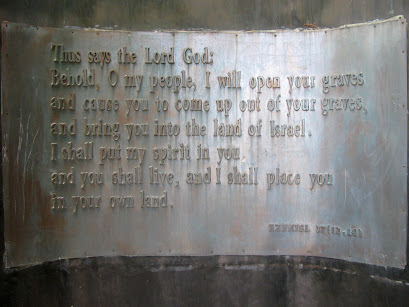The Scroll of Fire Memorial in the Jerusalem Hills commemorates the history of the Jewish people from the Holocaust up to the
Six-Day War. It is located in the Martyrs Forest which is the single largest memorial to the Holocaust in the world. The forest is comprised of six million trees which were planted in 1951. Four and half million pine trees represent the adults who perished in the Holocaust, while a million and a half cypress trees account for the children who perished.
The memorial,
Megilat Ha'esh in Hebrew
, was inaugurated in 1971. It is the work of Warsaw-born
Nathan Rapoport, himself a Holocaust survivor. He is known for his famous sculpture in Warsaw commemorating the
Ghetto Uprising, an exact copy of which is also featured at
Yad Vashem. Other sculptures can be found at
Kibbutz Yad Mordechai, as well as around the world.
The Scroll of Fire Memorial is made of bronze and is eight metres high. It is in the shape of two scrolls. The scroll on the right focuses on the Holocaust and its survivors, while the scroll on the left deals with the struggle to establish a new homeland and Israel's independence. In the space between the two scrolls there are two memorial rooms. In each one is engraved a quote from the bible, above.
On the right scroll one can see Jews being marched off to the concentration camps. Above them are figures devoid of faces. Only their helmets and bayonets show that they are Nazis, the idea being that their horrific acts wiped away their humanity and therefore they cannot be portrayed in full human form. Next, the
Warsaw Ghetto is seen with its flames and the defenders of the ghetto, an angel bearing a Molotov cocktail and a bearded man bearing a rock, are clearly visible. A mother and child can be seen ascending to the heavens in flames. This scroll ends with survivors of the camps seen leaving with their eyes raised in hope. A small boat represents the thousands who came to Israel in the pre-State days, during the
clandestine immigration era. An olive tree with branches formed from human bodies represents renewal. The central branch is depicted in a fetal position, epitomising the idea that even in the midst of destruction a new life/nation can be formed.



In the scroll on the left the symbols of the wandering Jew, a walking stick and a sack, are left behind, since the wandering is over and the Jew has reached his homeland. A man can be seen blowing a
shofar near the
Western Wall, while a child is holding a cluster of grapes, one of the
Seven Species with which
Eretz Israel, the Land of Israel, was endowed. A pregnant woman depicts the next generation that will be born into freedom. Finally,
the reunification of Jerusalem is depicted by a
menorah, carried by a group of soldiers. This menorah is symbolic of the menorah from the
Arch of Titus in Rome, which commemorated Roman suppression of the Jewish revolt. A small bearded man that supports the menorah is representative of the
Prophet Elijah and the sculptor's apparent belief in divine intervention.
The memorial stands on a wide platform overlooking the
coastal plain. It was restored in recent years and the site was made accessible to people with physical limitations.
In the same forest stands an extraordinary project in memory of the a German-Dutch diarist Anne Frank (1929-1945). Anne hid in Amsterdam with her family during the German occupation of the Netherlands and died in
Bergen-Belsen in 1945. Between 1942 to 1944 she documented her life in hiding in her diary.
Miep Gies, a family friend, found Anne's diary and gave it to her father,
Otto Frank, after the war. It became one of the most widely read books in the world.
Anne could see a chestnut tree through the window of her family's hideout. The tree, which is mentioned many times in her diary, was one of Amsterdam's oldest chestnut trees. In 2005 it was diagnosed with a disease. When municipal authorities wanted to cut it down, community members, tree experts and the staff of Bomenstichting (the Dutch national tree foundation) mobilised. The tree was fitted with a metal support structure but ultimately fell in a storm in 2010. Friends of
JNF (Jewish National Fund) in Holland initiated a project to commemorate Anne Frank and the tree in Israel.
The memorial includes several sculptural elements, all of which are significant. There is a circular route studded with quotes from Anne's diary translated into Hebrew and a very large cube representing the room where she hid from the Nazis with her family. The cube has three transparent sides, and the fourth is a tree with pentagonal leaves representing the chestnut tree. In a corner across from the tree there is an uncomfortably high seat. When you sit on it you feel like a child sitting on a high chair. The viewing experience is meant to recreate the feeling of imprisonment, isolation and discomfort, while looking longingly through a window at the world outside.
The memorial was created by the Dutch Jewish sculptor and Holocaust survivor,
Piet Cohen. Like Anne Frank, he was hidden in a house in southern Holland and was not discovered. He later served in the Israel Defence Forces.
The nearby Martyrs Cave (
B'nai B'rith Cave), above, is a natural cave that was expanded in order to serve as a site for reflection and remembrance of those who died in the Holocaust. In front of the cave there is a plaza and nearby there is a small recreation area with tables and benches which attracts many visitors throughout the year. To the left of the cave are steps that lead to the top of the mountain where the Scroll of Fire stands.
Every year on Holocaust Day, JNF and B'nai B'rith hold a memorial ceremony in this forest.
























































































